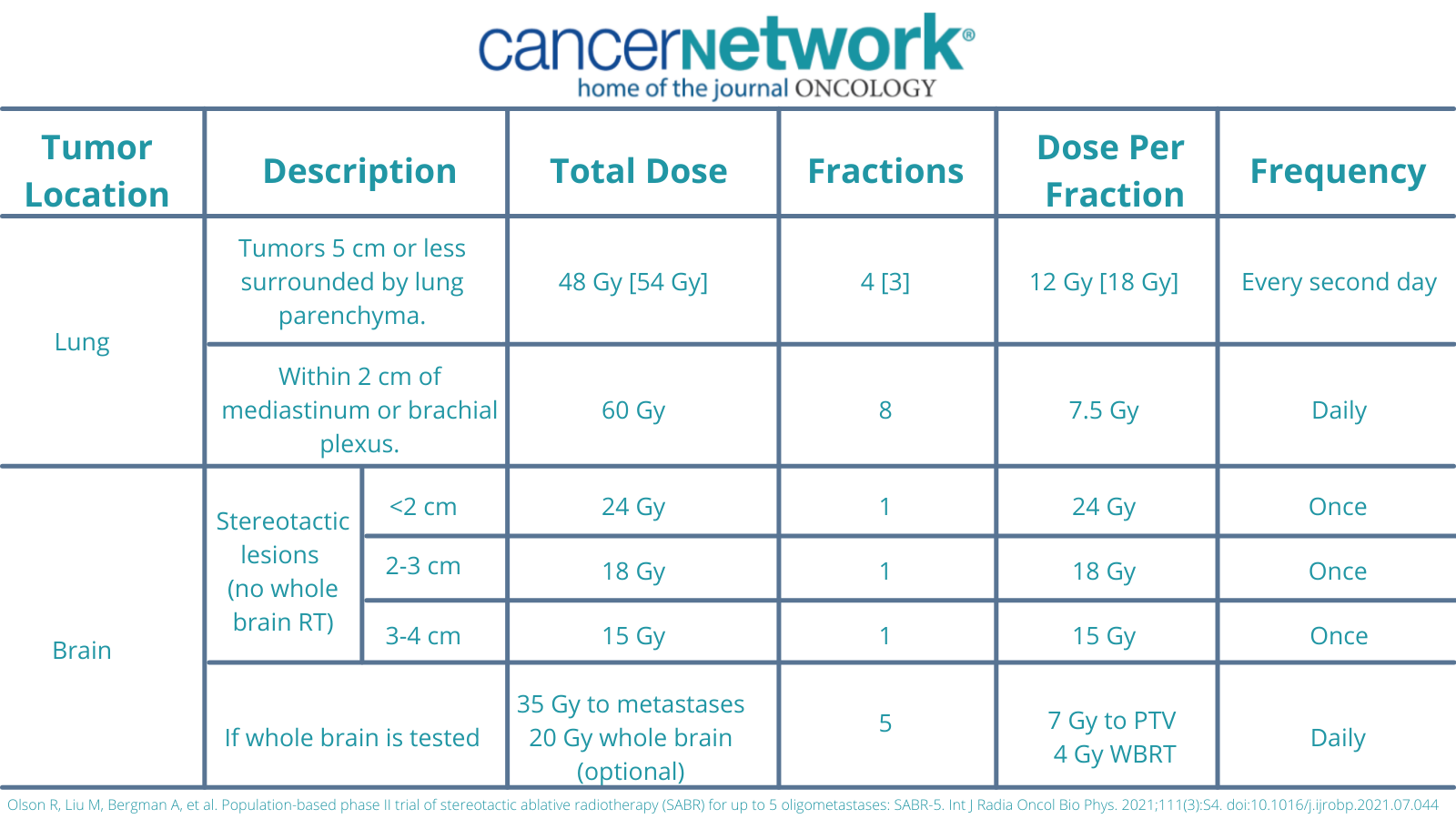Stereotactic Body Radiation Therapy Proves Relatively Safe to Use in Oligometastases
Patients with up to 5 oligometastases tolerated stereotactic body radiation therapy well, with investigators identifying a relatively safe toxicity profile of grade 2 or higher adverse effects.
Stereotactic body radiation therapy (SABR) for oligometastases was found to be relatively safe for patients, supporting further exploration in randomized phase 3 trials, according to results from the phase 2 SABR-5 study (NCT02933242) presented at the 2021 American Society for Radiation Oncology Annual Meeting (ASTRO).
Any grade adverse effects (AEs; defined as grade 2 or higher) were reported in 18.7% of patients. Specifically, grade 2 AEs were seen in 14.2% of patients, grade 3 in 4.2%, and grade 5 in 0.3%. The most common any grade AEs were pain (6.6%), spine fracture (1.9%), and neuropathy (1.6%). In terms of any grade toxicity by site, patients were reported to have experienced liver (27.3%), adrenal (26.7%), spine (22.1%), bone (19.5%), lymph node (18.5%), and lung (10.9%).
“It looks like toxicity from SABR provided in this provincially coordinated, and peer-reviewed setting, appears to be safe with a less than 5% grade 3 to 5 toxicity rates,” Robert Olson, associate head of research in the department of surgery, and the head of the Division of Radiation Oncology at the University of British Columbia, said in a presentation of the research. “Although the small numbers in the liver and adrenal, as well as the high percentages mean that we should be careful with this group, certainly this is a group that we should keep focusing our efforts.”
SABR details from the phase 2 SABR-5 study (NCT02933242), part 1.

Inclusion criteria for the population-based single arm trial required patients to have a controlled primary tumor, an ECOG performance status of 0 to 2. A life expectancy of at least 6 months was also required. Other criteria stated that patients could have up to 5 metastases in total if oligometastatic, as well as undergo staging with CT chest, abdomen, pelvis, and bone scan or PET scan. All disease sites needed to be safe to treat. Investigators enrolled a total of 399 patients.
The study’s primary end point was grade 2 or higher toxicity. Key secondary end points included progression-free survival (PFS), overall survival (OS), quality of life (QoL), lesional control rate, and time to starting or re-starting systemic therapy.
Notably, toxicities in the “other” category included ascites, hydronephrosis, esophagitis, proctitis, arm fibrosis, nausea and vomiting, bile duct stenosis, jaundice, death, adrenal insufficiency, fatigue, bloating, and shortness of breath.
SABR details from the phase 2 SABR-5 study (NCT02933242), part 2.

The median patient age was 68 years (range, 30-97) and most patients were male (68%). Prostate (32%) was the most common histology, followed by colorectal (14%), breast (11%), lung (9%), and renal (9%). Additionally, 25% of patients had another type of histology. Sixty-nine percent of patients were treated with SABR at 1 site, 21% received treatment at 2 sites, and 9% were treated at 3 sites or more. Lung and bone were the most commonly treated sites.
Excluding the other toxicity category, when toxicities were evaluated by site, the most significant grade 2 or higher toxicities included pneumonitis in the lung (3.1%), bone pain bone (11.4%), spine fracture (10.3%), neuropathy in the lymph node (3.7%), liver pain (18.2%), and adrenal constipation (13.3%). The most significant grade 3 or higher AEs were liver (13.6%), adrenal (6.7%), spine (5.9%), and bone (4.1%) toxicities.
When examining grade 2 or higher toxicity by year year, a total of 58 incidences (15.3%) were observed in year 1. Additionally, 14 (4.3%), 6 (3.0%), and 3 (3.7%) incidences were observed in years 2, 3, and 4, respectively. There were no incidences observed in year 5.
The 1 reported case of grade 5 toxicity was experienced by a patient who had colon cancer with metastases of the liver. The patient experienced biliary stenosis 15 months following treatment with SABR. This patient died due to recurring infection from the biliary stenosis.
OS was relatively good among patients receiving SABR, according to Olson. The population had a 1-year OS rate of 93%, a 2-year rate of 84%, a 3-year rate of 76%, and a 4-year rate of 70%.
A major limitation of the research is that it is not randomized, therefore it cannot assess what proportion of toxicities can be attributed to SABR versus the natural history of metastatic disease.
“Future studies should continue to focus on toxicity, given the relatively long OS in this patient population,” Olson concluded.
Reference
Olson R, Liu M, Bergman A, et al. Population-based phase II trial of stereotactic ablative radiotherapy (SABR) for up to 5 oligometastases: SABR-5. Int J Radia Oncol Bio Phys. 2021;111(3):S4. doi:10.1016/j.ijrobp.2021.07.044